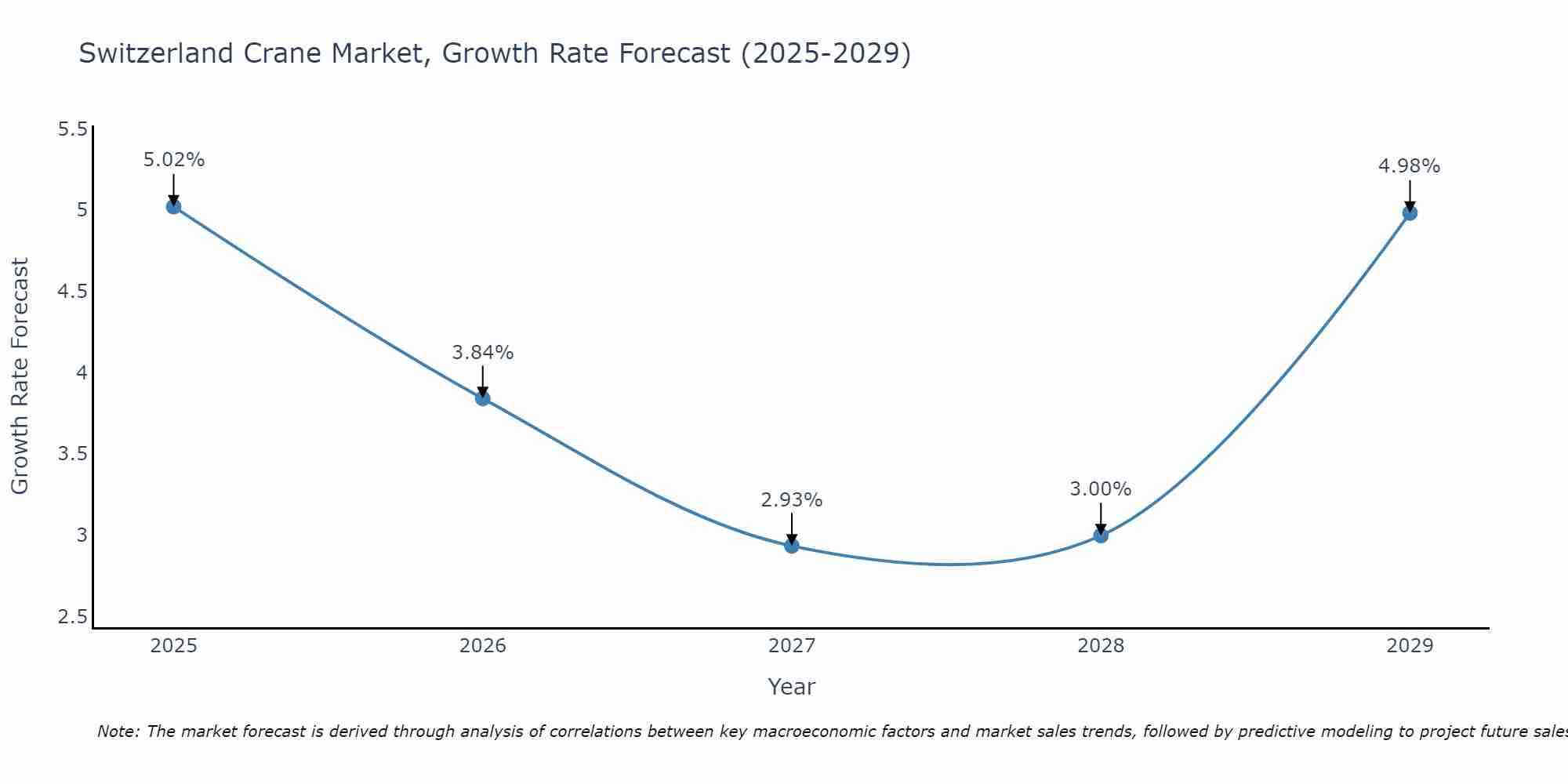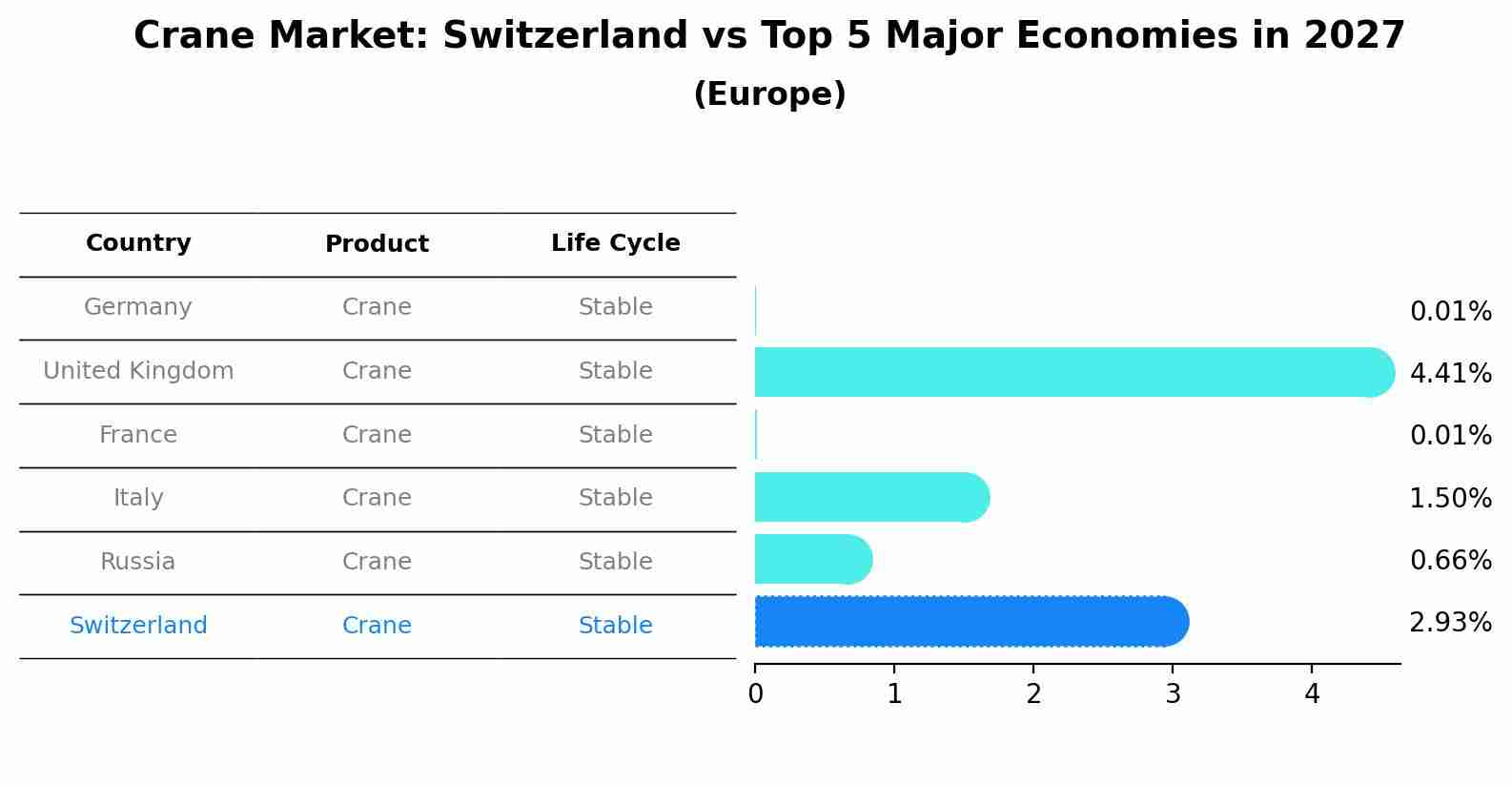Switzerland Crane Market (2025-2031) | Trends, Industry, Outlook, Value, Share, Segmentation, Revenue, Analysis, Forecast, Growth, Size & Companies
| Product Code: ETC4782656 | Publication Date: Nov 2023 | Updated Date: Aug 2025 | Product Type: Market Research Report | |
| Publisher: 6Wresearch | Author: Sachin Kumar Rai | No. of Pages: 60 | No. of Figures: 30 | No. of Tables: 5 |
Switzerland Crane Market Size Growth Rate
The Switzerland Crane Market is projected to witness mixed growth rate patterns during 2025 to 2029. Although the growth rate starts strong at 5.02% in 2025, it steadily loses momentum, ending at 4.98% by 2029.

Crane Market: Switzerland vs Top 5 Major Economies in 2027 (Europe)
By 2027, the Crane market in Switzerland is anticipated to reach a growth rate of 2.93%, as part of an increasingly competitive Europe region, where Germany remains at the forefront, supported by United Kingdom, France, Italy and Russia, driving innovations and market adoption across sectors.

Switzerland Crane Market Overview
The crane market in Switzerland is driven by the construction and infrastructure development sectors. As urbanization continues to rise, there is an increasing demand for cranes that facilitate lifting and moving heavy materials at construction sites. The market is characterized by a diverse range of crane types, including tower cranes, mobile cranes, and aerial work platforms. Technological advancements, such as automation and telematics, are enhancing crane efficiency and safety, while also addressing labor shortages in the industry. Additionally, stringent regulations regarding safety and environmental impact are shaping the market dynamics, prompting manufacturers to innovate and comply with evolving standards.
Drivers of the market
The crane market in Switzerland is driven by the booming construction and infrastructure development sectors. With ongoing investments in public infrastructure, such as transportation, utilities, and residential projects, there is a heightened demand for various types of cranes to facilitate construction activities. Additionally, technological advancements in crane design and operation, including improved safety features and enhanced lifting capabilities, attract more buyers. The growing trend of urbanization and the need for efficient logistics and material handling solutions also contribute significantly to the crane market`s expansion in the region.
Challenges of the market
The crane market in Switzerland faces significant regulatory challenges, particularly concerning safety standards and environmental regulations. Compliance with strict safety protocols requires continual investment in training and equipment updates. Furthermore, the market is impacted by fluctuating construction demands, influenced by economic conditions. The ongoing transition towards more sustainable construction practices may also require companies to adapt their fleets to accommodate new technologies, adding to operational costs.
Government Policy of the market
The crane market in Switzerland is influenced by construction industry growth and infrastructure development. Swiss government policies regarding urban planning and infrastructure investment significantly impact the demand for cranes. Safety regulations for construction equipment are stringent, with the Federal Office of Transport overseeing compliance. These policies ensure that cranes meet high safety standards, which is critical in a market characterized by advanced technology and engineering. The governments push for sustainable construction practices also drives innovations in crane technology.
Key Highlights of the Report:
- Switzerland Crane Market Outlook
- Market Size of Switzerland Crane Market, 2024
- Forecast of Switzerland Crane Market, 2031
- Historical Data and Forecast of Switzerland Crane Revenues & Volume for the Period 2021-2031
- Switzerland Crane Market Trend Evolution
- Switzerland Crane Market Drivers and Challenges
- Switzerland Crane Price Trends
- Switzerland Crane Porter`s Five Forces
- Switzerland Crane Industry Life Cycle
- Historical Data and Forecast of Switzerland Crane Market Revenues & Volume By Types for the Period 2021-2031
- Historical Data and Forecast of Switzerland Crane Market Revenues & Volume By Mobile Crane for the Period 2021-2031
- Historical Data and Forecast of Switzerland Crane Market Revenues & Volume By Fixed Crane for the Period 2021-2031
- Historical Data and Forecast of Switzerland Crane Market Revenues & Volume By Marine and Offshore Crane for the Period 2021-2031
- Historical Data and Forecast of Switzerland Crane Market Revenues & Volume By Applications for the Period 2021-2031
- Historical Data and Forecast of Switzerland Crane Market Revenues & Volume By Industrial Applications for the Period 2021-2031
- Historical Data and Forecast of Switzerland Crane Market Revenues & Volume By Marine and offshore for the Period 2021-2031
- Historical Data and Forecast of Switzerland Crane Market Revenues & Volume By Mining and Excavation for the Period 2021-2031
- Historical Data and Forecast of Switzerland Crane Market Revenues & Volume By Construction for the Period 2021-2031
- Historical Data and Forecast of Switzerland Crane Market Revenues & Volume By Other Applicants for the Period 2021-2031
- Switzerland Crane Import Export Trade Statistics
- Market Opportunity Assessment By Types
- Market Opportunity Assessment By Applications
- Switzerland Crane Top Companies Market Share
- Switzerland Crane Competitive Benchmarking By Technical and Operational Parameters
- Switzerland Crane Company Profiles
- Switzerland Crane Key Strategic Recommendations
Frequently Asked Questions About the Market Study (FAQs):
1 Executive Summary |
2 Introduction |
2.1 Key Highlights of the Report |
2.2 Report Description |
2.3 Market Scope & Segmentation |
2.4 Research Methodology |
2.5 Assumptions |
3 Switzerland Crane Market Overview |
3.1 Switzerland Country Macro Economic Indicators |
3.2 Switzerland Crane Market Revenues & Volume, 2021 & 2031F |
3.3 Switzerland Crane Market - Industry Life Cycle |
3.4 Switzerland Crane Market - Porter's Five Forces |
3.5 Switzerland Crane Market Revenues & Volume Share Segmentations, 2021 & 2031F |
3.6 Switzerland Crane Market Revenues & Volume Share, By Applications, 2021 & 2031F |
4 Switzerland Crane Market Dynamics |
4.1 Impact Analysis |
4.2 Market Drivers |
4.2.1 Increasing construction activities in Switzerland |
4.2.2 Government investments in infrastructure development |
4.2.3 Adoption of advanced technologies in crane manufacturing |
4.3 Market Restraints |
4.3.1 High initial investment cost for cranes |
4.3.2 Stringent regulations regarding crane operations and safety standards |
5 Switzerland Crane Market Trends |
6 Switzerland Crane Market Segmentations |
6.1 Switzerland Crane Market Segmentations |
6.1.1 Overview and Analysis |
6.1.2 Switzerland Crane Market Revenues & Volume, By Mobile Crane, 2021-2031F |
6.1.3 Switzerland Crane Market Revenues & Volume, By Fixed Crane, 2021-2031F |
6.1.4 Switzerland Crane Market Revenues & Volume, By Marine and Offshore Crane, 2021-2031F |
6.2 Switzerland Crane Market, By Applications |
6.2.1 Overview and Analysis |
6.2.2 Switzerland Crane Market Revenues & Volume, By Industrial Applications, 2021-2031F |
6.2.3 Switzerland Crane Market Revenues & Volume, By Marine and offshore, 2021-2031F |
6.2.4 Switzerland Crane Market Revenues & Volume, By Mining and Excavation, 2021-2031F |
6.2.5 Switzerland Crane Market Revenues & Volume, By Construction, 2021-2031F |
6.2.6 Switzerland Crane Market Revenues & Volume, By Other Applicants, 2021-2031F |
7 Switzerland Crane Market Import-Export Trade Statistics |
7.1 Switzerland Crane Market Export to Major Countries |
7.2 Switzerland Crane Market Imports from Major Countries |
8 Switzerland Crane Market Key Performance Indicators |
8.1 Number of construction permits issued in Switzerland |
8.2 Adoption rate of automation and IoT technologies in crane operations |
8.3 Average age of cranes in operation |
9 Switzerland Crane Market - Opportunity Assessment |
9.1 Switzerland Crane Market Opportunity Assessment Segmentations, 2021 & 2031F |
9.2 Switzerland Crane Market Opportunity Assessment, By Applications, 2021 & 2031F |
10 Switzerland Crane Market - Competitive Landscape |
10.1 Switzerland Crane Market Revenue Share, By Companies, 2024 |
10.2 Switzerland Crane Market Competitive Benchmarking, By Operating and Technical Parameters |
11 Company Profiles |
12 Recommendations | 13 Disclaimer |
- Single User License$ 1,995
- Department License$ 2,400
- Site License$ 3,120
- Global License$ 3,795
Search
Thought Leadership and Analyst Meet
Our Clients
Related Reports
- Vietnam System Integrator Market (2025-2031) | Size, Companies, Analysis, Industry, Value, Forecast, Growth, Trends, Revenue & Share
- ASEAN and Thailand Brain Health Supplements Market (2025-2031) | Strategy, Consumer Insights, Analysis, Investment Trends, Opportunities, Growth, Size, Share, Industry, Revenue, Segments, Value, Segmentation, Supply, Forecast, Restraints, Outlook, Competition, Drivers, Trends, Demand, Pricing Analysis, Competitive, Strategic Insights, Companies, Challenges
- ASEAN Bearings Market (2025-2031) | Strategy, Consumer Insights, Analysis, Investment Trends, Opportunities, Growth, Size, Share, Industry, Revenue, Segments, Value, Segmentation, Supply, Forecast, Restraints, Outlook, Competition, Drivers, Trends, Demand, Pricing Analysis, Competitive, Strategic Insights, Companies, Challenges
- Europe Flooring Market (2025-2031) | Outlook, Share, Industry, Trends, Forecast, Companies, Revenue, Size, Analysis, Growth & Value
- Saudi Arabia Manlift Market (2025-2031) | Outlook, Size, Growth, Trends, Companies, Industry, Revenue, Value, Share, Forecast & Analysis
- Uganda Excavator, Crane, and Wheel Loaders Market (2025-2031) | Strategy, Consumer Insights, Analysis, Investment Trends, Opportunities, Growth, Size, Share, Industry, Revenue, Segments, Value, Segmentation, Supply, Forecast, Restraints, Outlook, Competition, Drivers, Trends, Demand, Pricing Analysis, Competitive, Strategic Insights, Companies, Challenges
- Rwanda Excavator, Crane, and Wheel Loaders Market (2025-2031) | Strategy, Consumer Insights, Analysis, Investment Trends, Opportunities, Growth, Size, Share, Industry, Revenue, Segments, Value, Segmentation, Supply, Forecast, Restraints, Outlook, Competition, Drivers, Trends, Demand, Pricing Analysis, Competitive, Strategic Insights, Companies, Challenges
- Kenya Excavator, Crane, and Wheel Loaders Market (2025-2031) | Strategy, Consumer Insights, Analysis, Investment Trends, Opportunities, Growth, Size, Share, Industry, Revenue, Segments, Value, Segmentation, Supply, Forecast, Restraints, Outlook, Competition, Drivers, Trends, Demand, Pricing Analysis, Competitive, Strategic Insights, Companies, Challenges
- Angola Excavator, Crane, and Wheel Loaders Market (2025-2031) | Strategy, Consumer Insights, Analysis, Investment Trends, Opportunities, Growth, Size, Share, Industry, Revenue, Segments, Value, Segmentation, Supply, Forecast, Restraints, Outlook, Competition, Drivers, Trends, Demand, Pricing Analysis, Competitive, Strategic Insights, Companies, Challenges
- Israel Intelligent Transport System Market (2025-2031) | Strategy, Consumer Insights, Analysis, Investment Trends, Opportunities, Growth, Size, Share, Industry, Revenue, Segments, Value, Segmentation, Supply, Forecast, Restraints, Outlook, Competition, Drivers, Trends, Demand, Pricing Analysis, Competitive, Strategic Insights, Companies, Challenges
Industry Events and Analyst Meet
Whitepaper
- Middle East & Africa Commercial Security Market Click here to view more.
- Middle East & Africa Fire Safety Systems & Equipment Market Click here to view more.
- GCC Drone Market Click here to view more.
- Middle East Lighting Fixture Market Click here to view more.
- GCC Physical & Perimeter Security Market Click here to view more.
6WResearch In News
- Doha a strategic location for EV manufacturing hub: IPA Qatar
- Demand for luxury TVs surging in the GCC, says Samsung
- Empowering Growth: The Thriving Journey of Bangladesh’s Cable Industry
- Demand for luxury TVs surging in the GCC, says Samsung
- Video call with a traditional healer? Once unthinkable, it’s now common in South Africa
- Intelligent Buildings To Smooth GCC’s Path To Net Zero


















